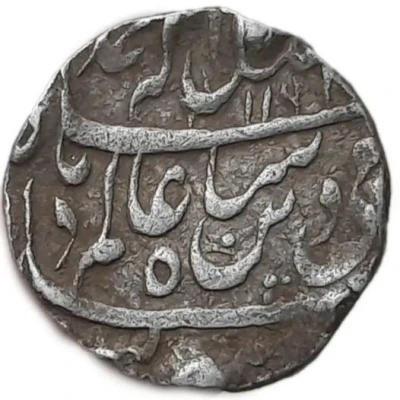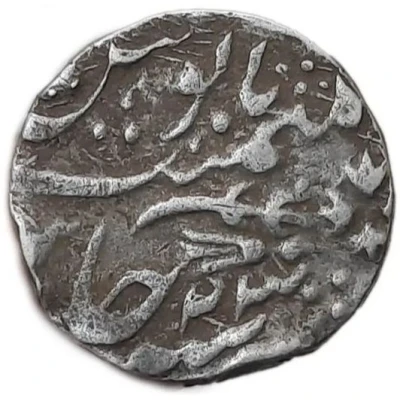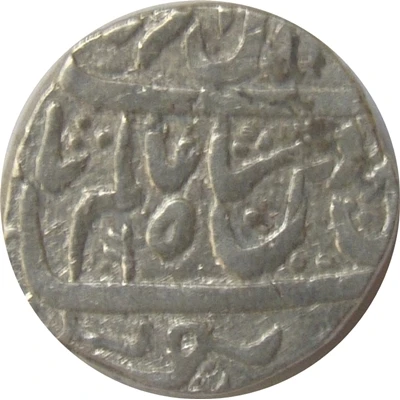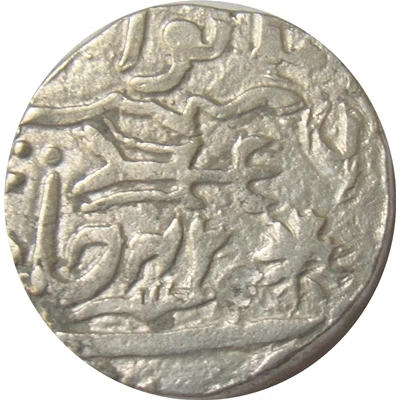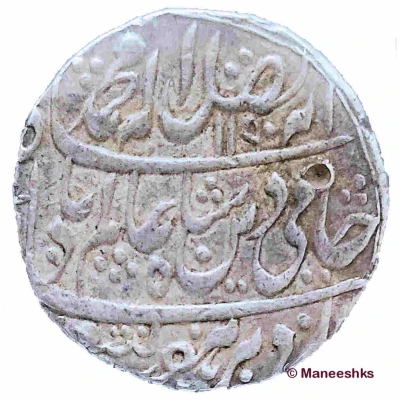
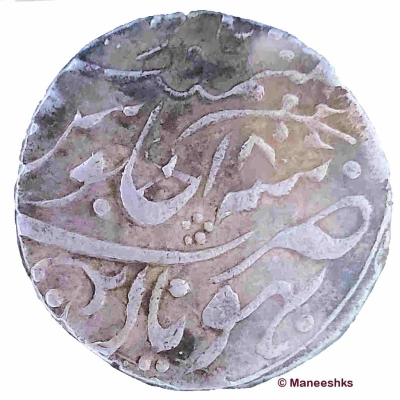

© Maneeshks (CC BY-NC)
1 Rupee - Nawab Faiz Mohammad Khan, Bhopal mint
1190 (1776) year| Silver | 11.23 g | 21 mm |
| Issuer | Princely state of Bhopal (Indian princely states) |
|---|---|
| Type | Standard circulation coin |
| Year | 1190 (1776) |
| Calendar | Islamic (Hijri) |
| Value | 1 Rupee |
| Currency | Rupee (1723-1947) |
| Composition | Silver |
| Weight | 11.23 g |
| Diameter | 21 mm |
| Shape | Round |
| Orientation | Coin alignment ↑↓ |
| Demonetized | Yes |
| Updated | 2024-10-05 |
| Numista | N#303504 |
|---|---|
| Rarity index | 94% |
Reverse
Regnal year in AH
Lettering: ۱۸
Translation: 18
Edge
Plain
Comment
History of BhopalAccording to the legends, it is believed that Bhopal was established by King Bhoja of Paramara. Some other historians claim that the state is named after king Bhupala. Bhojeshwar Temple is also situated close to the present-day city. There are certain theories which suggest that the state is named after this wonderful temple. However, there is no evidence to support these assumptions.
According to historical evidence, Dost Mohammad Khan founded Bhopal state. He was a Pashtun soldier who served the Mughal Army. He started offering mercenary services to local rulers after the death of Aurangzeb in Malwa region which was politically instable. He bought Berasia estate in 1709 on lease. He went on to occupy Mangalgarh from Rajputs. He was also offering mercenary services to Gond kingdom which was ruled by Rani Kamlapati. After the female rulers of the kingdom died, he took control over the region. Dost Mohammad captured several other territories of Malwa region. He fortified Bhopal city in 1720s and was named as the Nawab.
Dost Mohammad Khan belonged to Pathan Orakzai dynasty which was responsible for the Islamic influence in Bhopal state. He also built a fort and settlement at Islamnagar. He died in 1728 and Bhopal state was governed by other rulers from Orakzai dynasty after that. The state was under the Marathas, who defeated the Mughals and the Nawab of Bhopal at the Battle of Bhopal in 1737.
Nawab Yar Mohammad Khan was the next king in Bhopal history who ruled from 1728 to 1742. He shifted the capital to Islamnagar. The next king Nawab Faiz Muhammed Khan ruled from 1742 to 1777 and shifted the capital back to Bhopal. Faiz Muhammad Khan was extremely religious and the state was run by his stepmother Mamola Bai.
Bhopal Princely State was formed under the British regime in 1818.
Queens of Bhopal State
Qudsia Begum was the first woman ruler of Bhopal who came into power in 1819. Her only daughter Sikandar Begum became the next queen. Sikandar Begum’s only daughter, Shah Jahan Begum became the next queen. Sultan Shah Jahan Begum was the last women ruler. She ruled for 25 years, after which her son, Hamidullah Khan was enthroned as the next king. The Begams were responsible for introducing several reforms related to waterworks, railways and postal system. Bhopal Princely state was constituted as a municipality in 1907.
Post independence
Nawab Hamidullah Khan participated in the independence movement and attended the Round Table Conference from 1930–1932. He was also a member of the All-India Muslim League and was friends with Muhammad Ali Jinnah. He wanted to retain Bhopal Princely state as an independent state and did not want to join India or Pakistan after partition. Several violent agitations took place where many prominent protestors were arrested. Some were also shot by Nawabi Police.
Sardar Patel stepped forward and Bhopal finally became a part of India on 30th April 1949. The Union Government of India took control of princely state of Bhopal from June 1949.
Interesting fact
One interesting fact about this coin is that it was minted during the reign of Nawab Faiz Mohammad Khan, who was the ruler of the Princely state of Bhopal in India during the 18th century. The coin is a rare example of the silver rupee coins that were minted during his reign, and it is considered a valuable collector's item among numismatists today.
